MoMI First Look Review: “Babi Yar. Context” and “Mr. Landsbergis” Are Archival Masterworks
Written by: Christopher Llewellyn Reed | March 24th, 2022

Babi Yar. Context (Sergei Loznitsa, 2021) and Mr. Landsbergis (Sergei Loznitsa, 2021) 3½ out of 4 stars.
If one is interested in archival filmmaking, then Ukrainian director Sergei Loznitsa is the filmmaker for you. In 2021, alone, he released two films clocking in at over 6 hours, Babi Yar. Context and Mr. Landsbergis (the latter of which takes up two-thirds of that runtime). The first explains the before and after of the horrific 1941 Nazi massacre of 33,771 Jews at the titular ravine, near Kiev, and the second the Lithuanian liberation movement of the early 1990s that contributed to the collapse of the Soviet Union. Both are showcases of phenomenal research and editing talent. Loznitsa (Donbass) may have just been kicked out of the Ukrainian Film Academy (for opposing a boycott of Russian cinema), but his work is very much worth watching by everyone who values history (and even more so by those ignorant of it).
The footage we see in Babi Yar. Context was filmed, without sound, by either Nazis or Soviets and is presented here with carefully recreated audio, the better to immerse the audience in the viewing experience. Most of it is black and white, but Loznitsa uses occasional color material for visual variety. All of it is disturbing and compelling, plunging us into the atrocities of World War II and its genocidal Holocaust.
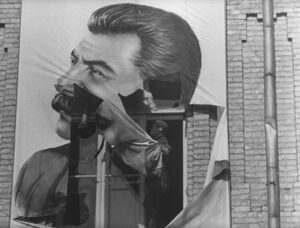
Loznitsa is not here merely to document the past, however, but to explore the nature of memory and complexity of responsibility. The party line after the Red Army retook Ukraine from the Germans in 1943 (after a two-year occupation) was that all wrongdoing and murder had been solely at the hands of fascist invaders. The truth is not so simple.
Many Ukrainians were, with good reason, extremely resentful of their Russian overlords, going back not only to imperial days but also to the previous decade, when Stalin’s policies led to mass starvation in the region. As a result, with or without any anti-Semitism, sizable portions of the population greeted the Nazis as saviors, which we see here. That, coupled with the unfortunate traditional hatred and suspicion of Jews among some, resulted in plenty of folks joining in to assist with the ethnic cleansing following invasion.
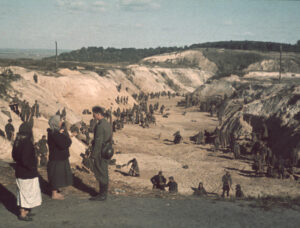
Loznitsa presents the images without much commentary, except for the occasional text that pops up to explain and explicate the footage. Preferring to let the juxtaposition of shots and scenes do the work, he does as the title promises, bringing context to the tragedy. Of particular interest to him is how the events at Babi Yar were later framed as a purely Nazi-perpetrated mass killing. Though no doubt many Ukrainians resisted and risked their lives in opposition, the truth of who did what is far more complex than the official post-war narrative adopted by the Soviets.
Staying in the USSR, but jumping forward to its demise, Loznitsa trains his lens on Lithuania, with the country’s first post-Soviet head of state, Vytautas Landsbergis, as his primary subject. A work of meticulous detail, the four-hour (and change) Mr. Landsbergis documents how this tiny Baltic nation stood up to its oppressor and emerged victorious. Again showcasing a rich trove of archival footage, this time intercut with an interview with his almost-nonagenarian subject, Loznitsa is nothing if not thorough in his storytelling approach.
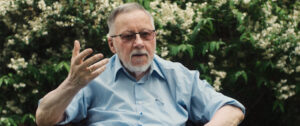
A part of the Russian Empire since the late 18th century, Lithuania—along with neighbors Estonia and Latvia—had successfully established its independence towards the end of World War I. A little over 20 years later, as the Germans and Soviets divided Eastern Europe between them under the terms of the Molotov-Ribbentrop Pact, the three countries became vassal states once more. Though much was made of communist ideals of equality and unity over the ensuing decades, the populace never lost its taste for freedom.
We start in 1988, as then-Soviet Premier Mikhail Gorbachev’s policies of “glasnost” (openness) and “perestroika” (restructuring) were in full swing, the leader hoping that this loosening of restrictive policies would help revitalize the country’s flagging economy. What happened, instead, was a rather sudden surge of popular discontent with the status quo, with some republics outside of the central Russian one—not to mention the ostensibly sovereign states of Eastern Europe—clamoring for independence from Moscow.
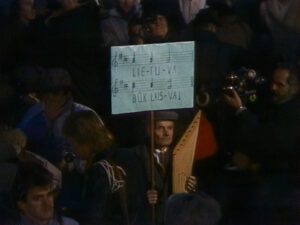
Back and forth we go, with the historical material (and I would love to know where and how Loznitsa got his cinematic hands on this impressive archive) interrupted and commented on by Landsbergis. We watch as Gorbachev is at first all smiles (though he hates being called “Mr.,” preferring the honorific “Comrade”) and then far less happy. He knows that if Lithuania is able to pull away, the dam may break.
Yet little by little, the people vote and elect representatives who do what they were chosen to do and, by the book and by the law, Landsbergis and his cohorts separate from the Soviet body politic. The Red Army comes in, violence ensues, people die, people resist, and eventually Gorbachev’s bluff is called. Though he is not the hero of the piece, here, Gorbachev still deserves credit of a kind for not going full-Stalin or what we must now must call full-Putin, as his fellow Politburo members no doubt wished he would. In 1991, as Lithuania, free once more, emerged on the world stage, Gorbachev was about to lose his own country. So it goes.
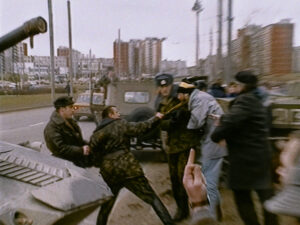
Given the length of the movie, I wish Loznitsa had asked Landsbergis to meditate on then and now, and how Russian leadership has returned to aspirations of empire. How does he see Putin in the context of it all? That caveat notwithstanding, Mr. Landsbergis is a monumental achievement, joining Babi Yar. Context as a powerful treatment of an important historical moment. These films may require a lot of your attention span, but the rewards are well worth the effort.
[Both films played at the recent Museum of the Moving Image First Look Festival, which ran March 16-20, 2022.]

